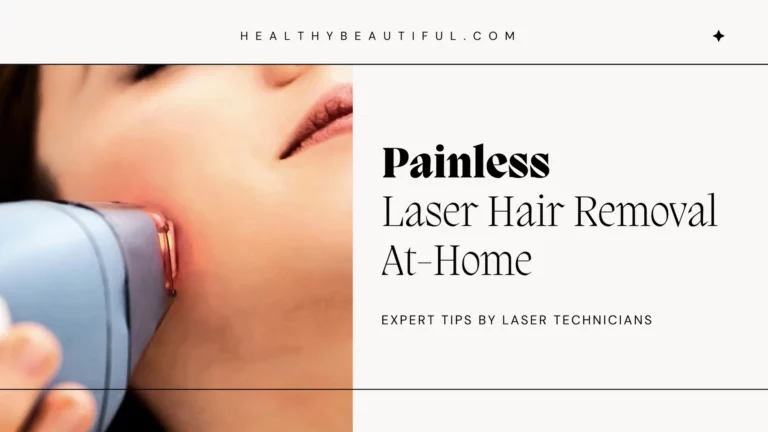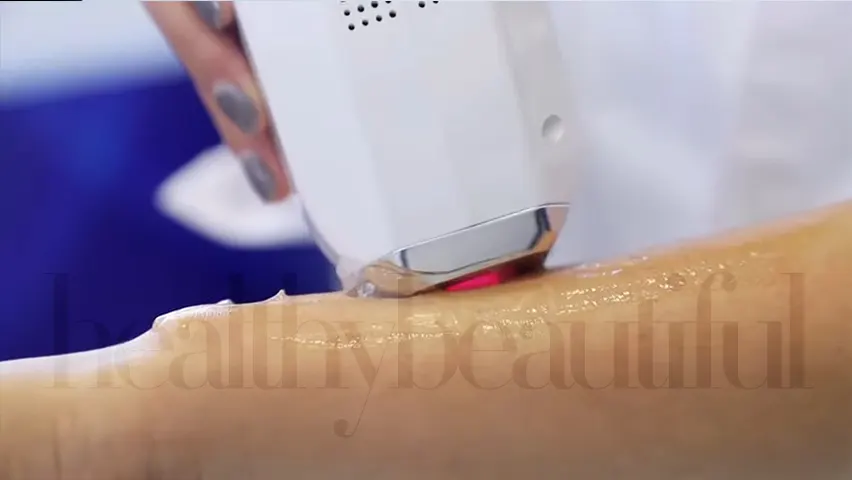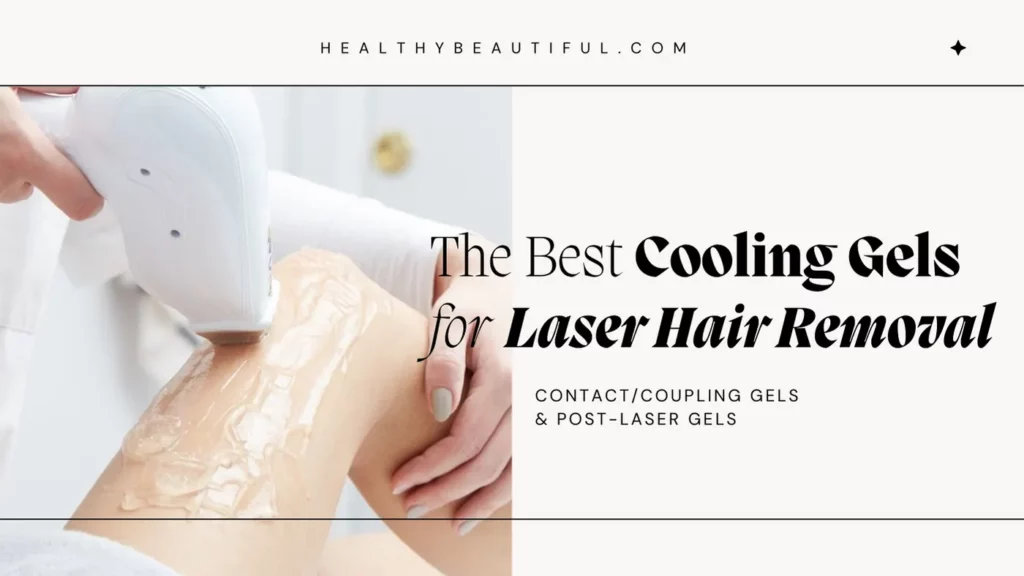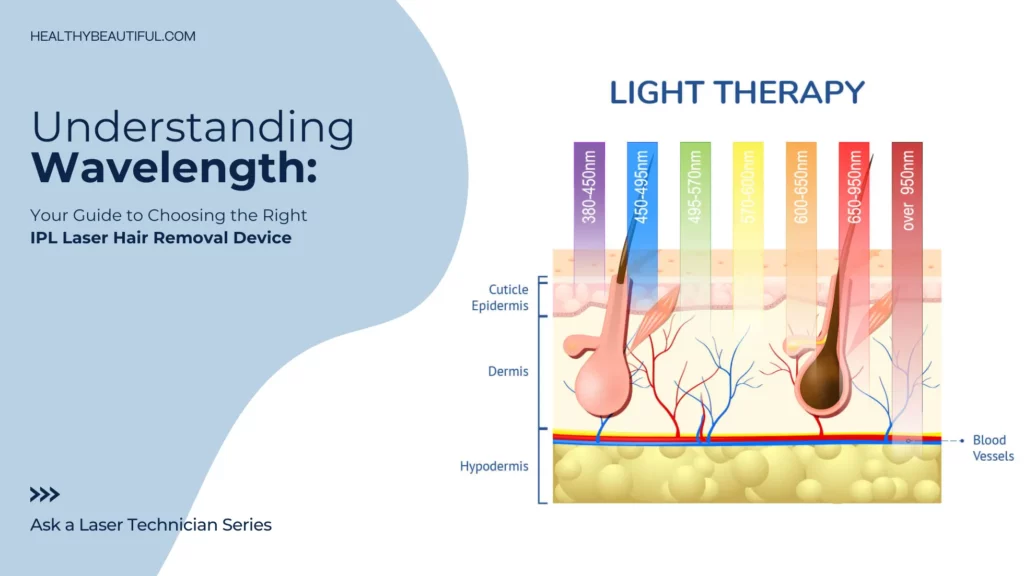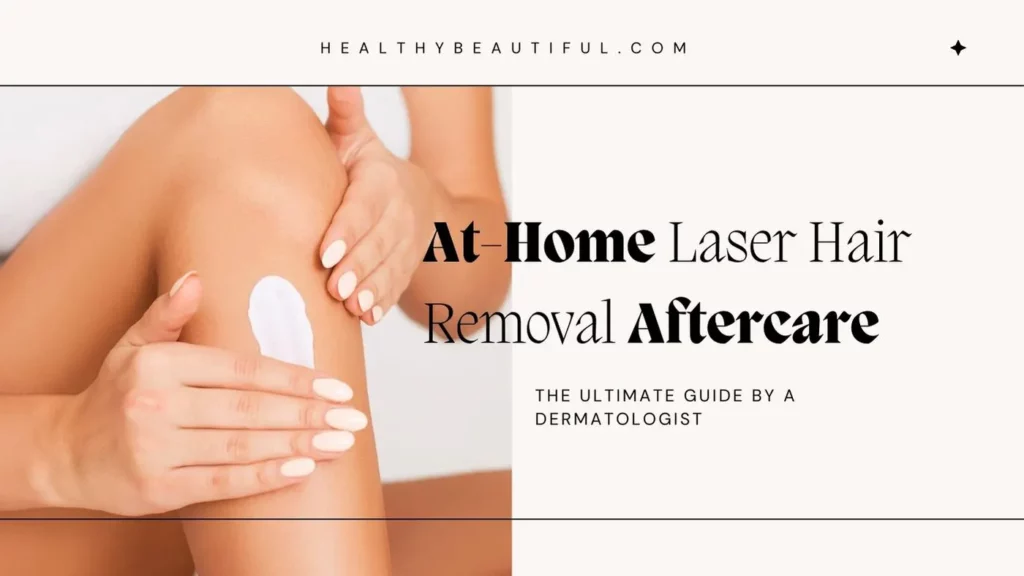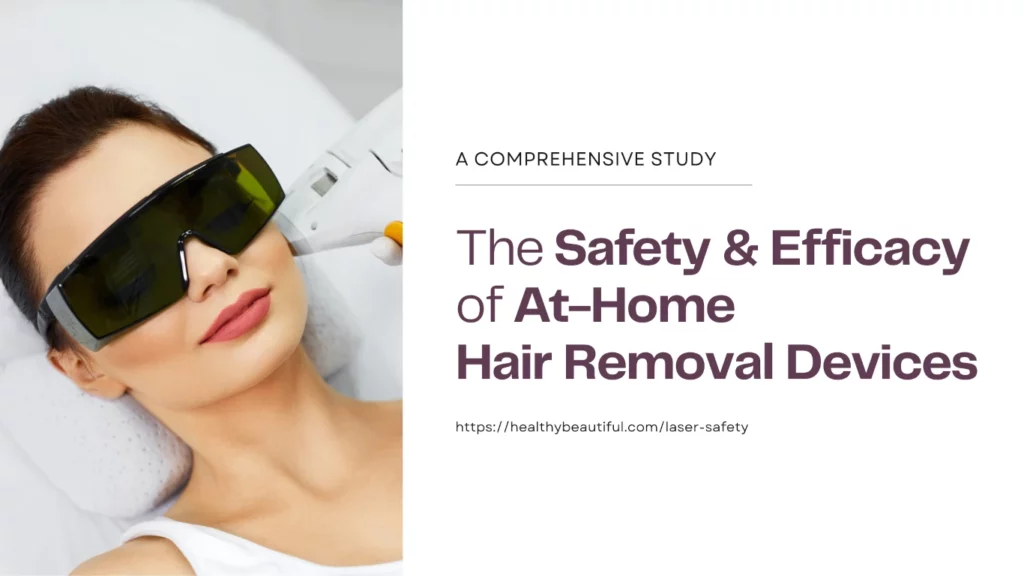Experience Pain-free Laser Hair Removal
I understand how frustrating and uncomfortable unwanted hair can be.
You may have tried shaving, waxing, or depilatory creams, but found them to be painful, irritating to the skin, or just too time-consuming to keep up with. Laser hair removal can provide a more long-lasting solution with minimal discomfort.
Traditionally, you'd need to go to a professional laser clinic or salon for these treatments, requiring multiple sessions over time at a significant cost.
But good news! Recent advancements now allow you to achieve painless laser hair removal from the convenience of your very own home.
At-home laser hair removal devices have become much more accessible and affordable.
These pain-free home devices use technologies like advanced cooling and skin tone sensors to minimize discomfort.
You can finally get long-lasting hair reduction on your own schedule and within your own budget.
In this guide, I'll fully explain painless at-home laser hair removal. I'll cover the different types of devices, how they work, and provide step-by-step instructions so you can use them effectively and safely. I'll also share techniques for managing any minor discomfort and talk about proper post-treatment care.
My goal is to give you all the information you need about at-home laser hair removal so you can decide if this innovative option is right for you. It can provide a hassle-free way to achieve smooth, hair-free skin without the pain, cost, and inconvenience of traditional laser treatments.

Ask the Expert: What are the best painless at-home laser hair removal devices, & which one would you recommend for me?
BY SAMANTHA WELCH, ESTHETICIAN
While some level of mild tingling or warmth can occur with at-home treatments, there are absolutely devices designed to provide a virtually pain-free experience.
The top painless options I'd recommend rely on advanced cooling systems or adjustable energy levels to minimize any discomfort.
Diode lasers like the ViQure EpiPro uses TEC combined with cooling gel and the SHR technique to continuously cool the skin during use of high energy.
IPL devices like the Ulike Sapphire Air3, NAISIGOO, and the JOVS X 3-in-1 also have cooling tips that counteract the warmth from IPL pulses.
Other models like The BEAM, the Braun Skin Expert, and the SmoothSkin Pure FIT have skin tone sensors that auto-adjust the energy levels according to your skin tone. This safety mechanism makes sure you will never flash energy high enough to damage your skin and cause pain.
These are the best we recommend from among the 50 devices we’ve charted and reviewed below.
I always reinforce that some mild temporary redness or tingling is normal with any laser hair removal, but the latest devices have made huge strides in pain management.
With the right painless model for your skin and hair, you can absolutely achieve long-lasting smooth results at home with little to no discomfort.
- Experience Pain-free Laser Hair Removal
- Ask the Expert: What are the best painless at-home laser hair removal devices, & which one would you recommend for me?
- Buying Cheat Sheet: The Best Painless At-Home Laser Hair Removal Devices
- Cheat Sheet: The Latest Pain-free At-Home Laser Hair Removal Devices
- Understanding Laser Hair Removal
- Understanding Pain-Free Laser Hair Removal
- Choosing the Right Pain-free Laser Hair Removal Device for Home Use
- How to Make Laser Hair Removal Less Painful
- Preparing for Painless Laser Hair Removal At-Home
- Post-Treatment Care and Maintenance
- Emerging Technologies in At-Home Laser Hair Removal
- References:
Buying Cheat Sheet: The Best Painless At-Home Laser Hair Removal Devices
Our team of estheticians have operated and tested over 35 professional laser hair removal machines over the years. These FDA-approved devices are our current choices for the best at-home laser hair removal in the market today.
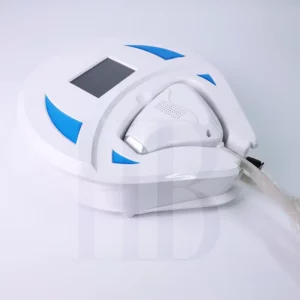
ViQure EpiPro for Salon & Home Use
BEST AT-HOME LASER HAIR REMOVAL DEVICE (OVERALL inc. DARK SKIN / BLONDE HAIR / FACE / BRAZILIAN)
Combines a high-energy 808nm diode laser with TEC cooling, making this more effective than any IPL device.
This unique hybrid machine is from a brand that caters to Medspas. This allows you to get virtually unlimited treatments from the same tech professionals use.
If you have the budget to invest, the ViQure EpiPro is the best at-home laser hair removal money can buy.
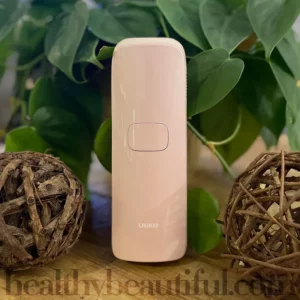
Ulike Sapphire Air3
BEST IPL DEVICE
Vogue's Best Laser Hair Removal Device of 2023 is incredibly fast, portable, and pain-free with its Sapphire Ice-Cooling Technology.
And with a whopping 1 million flashes & 30 international safety certifications, the extremely popular Ulike Sapphire Air3 reigns supreme among all IPL devices.
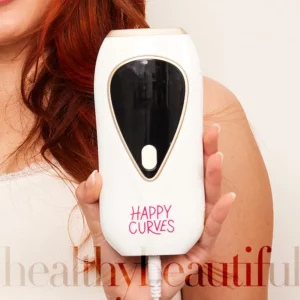
The Beam IPL
BEST BUDGET LASER HAIR REMOVAL
A great affordable alternative to high-end devices.
Boasts premium features like Smart Skin-Sensing, a digital display, contact sensors, and 600,000 flashes worth 20 years of treatments.
The Beam IPL is beginner-friendly & has unbelievable value for money.
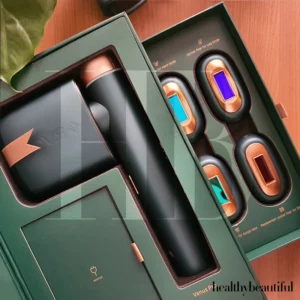
JOVS Venus Pro
MOST INNOVATIVE IPL
Known as “The Dyson of Laser Hair Removal,” the award-winning JOVS Venus Pro is known for its exceptional design & build quality.
This futuristic IPL + Skin Rejuvenation device delivers painless treatments using cutting-edge OPT & Sapphire ICE technology.
It also features an ergonomic 330° Rotation Head that matches any curvature and 6 Body + 6 Level Modes that offer full-body treatments.
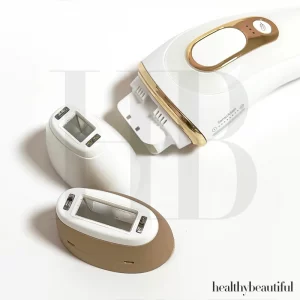
Braun Silk-Expert Pro 5
MOST USER-FRIENDLY IPL DEVICE
The Silk Expert Pro 5 is ELLE Editor's Choice 2021 and dermatologically accredited by the Skin Health Alliance.
Braun’s best IPL is incredibly beginner-friendly and takes the guesswork out of your treatments.
Its Skin Pro 2.0 sensor scans your skin tone & automatically sets it to the perfect energy fluence with every flash.
Cheat Sheet: The Latest Pain-free At-Home Laser Hair Removal Devices
Esthetician Tip: Save time by process of elimination. Compare by skin tone coverage, technology, power, safety (cooling), and other features.

| wdt_ID | Image | Device/Brand | Product | Max Energy Fluence | Skin Tone Coverage | I | II | III | IV | V | VI | Cooling/Pain-free |
|---|---|---|---|---|---|---|---|---|---|---|---|---|
| 1 | 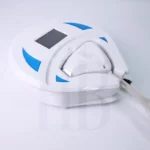 |
https://healthybeautiful.com/review/viqure-depimini-808nm-diode-laser-machine-in-depth-esthetician/ | ViQure EpiPro Diode Laser | 20.0 | I-VI | Y | Y | Y | Y | Y | Y | Advanced Thermoelectric Cooling + Wind Cooling (0°C~5°C) + Cooling gel |
| 2 | 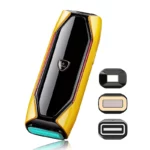 |
https://healthybeautiful.com/JOVS-X-3-in-1-IPL | JOVS X™ 3-in-1 IPL (OPT) | 7.0 | I-V | Y | Y | Y | Y | Y | Sapphire Cooling System | |
| 3 | 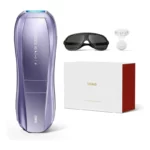 |
https://healthybeautiful.com/Ulike-Air-10 | Ulike Air 10 | 6.7 | I-IV | Y | Y | Y | Y | 65°F/18°C | ||
| 4 | 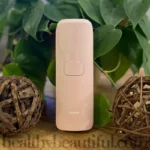 |
https://healthybeautiful.com/review/ulike-sapphire-air3-an-in-depth-review-by-estheticians/ | Ulike Sapphire Air3 | 7.2 | I-IV | Y | Y | Y | Y | Sapphire Cooling 10-20°C (50-68°F) | ||
| 5 | 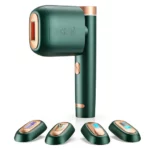 |
https://healthybeautiful.com/Bosidin-Pioneer-Pro-Official | BoSidin Pioneer-Pro (OPT) | 6.0 | I-V | Y | Y | Y | Y | Y | Dynamic Cooling Device (DCD) |
Understanding Laser Hair Removal
Laser hair removal works by targeting the pigment (melanin) in the hair follicles with concentrated beams of light energy. The light is absorbed by the melanin, which converts it into heat. This heat then damages the hair follicle, inhibiting future hair growth.
The process is most effective when the hair follicles are in their active growth phase (anagen phase). During this phase, the hair follicles contain the highest concentration of melanin, making them more susceptible to the laser's energy.
Different Types of Laser Hair Removal Technologies

There are several types of laser technologies used for hair removal, each with its own unique characteristics:
- Diode lasers (800-810 nm) – These lasers emit a specific wavelength of light that is well-absorbed by melanin. They are among the most commonly used lasers for hair removal and are effective for a wide range of skin tones.
- Alexandrite lasers (755 nm) – These lasers emit a slightly shorter wavelength of light than diode lasers, making them more suitable for individuals with lighter skin tones.
- Nd:YAG lasers (1064 nm) – These lasers emit a longer wavelength of light that can penetrate deeper into the skin, making them a good choice for individuals with darker skin tones.
- Intense Pulsed Light (IPL) – IPL is not technically a laser but a broad-spectrum light source that emits multiple wavelengths of light. It is generally less powerful than lasers but is more affordable and suitable for larger treatment areas.
What Causes Pain During Laser Hair Removal?
There are several reasons why certain laser hair removal methods can be painful:
- Inadequate prep – Not shaving prior. These protruding strands will collect heat and stick to your skin as well as the window of your device.
- Inadequate cooling or numbing – Built-in safety mechanisms and the use of cooling gels can help minimize discomfort during the treatment.
- Unsuitable energy level – Energy levels set too high without proper cooling can generate excess heat.
- Improper technique – If the laser machine is not used correctly, it can cause excessive heat and discomfort.
- Sensitive skin – Certain skin types or conditions are more reactive to the heat generated by the laser.
- Treatment area – Certain areas of the body, such as the bikini line or upper lip, have thinner skin and are more sensitive to pain.
- Hair density and thickness – Areas with denser or thicker hair may require higher energy levels, which can increase the likelihood of discomfort.
- Hair and skin type – The contrast between hair and skin color can impact the effectiveness and comfort of laser hair removal. Greater contrast (dark hair on light skin) typically results in better absorption of light energy and less discomfort, while less contrast (light hair on light skin or dark hair on dark skin) can lead to decreased effectiveness and increased discomfort.
- Laser technology – Some laser hair removal technologies, such as diode and alexandrite lasers, can be more painful than others due to their specific wavelengths and energy levels.
By understanding how laser hair removal works and the potential causes of discomfort, you can better prepare for a more comfortable and effective treatment experience.
Understanding Pain-Free Laser Hair Removal
Laser hair removal has traditionally been associated with some level of discomfort or pain. However, advancements in technology have introduced a new generation of painless laser hair removal machines designed for safe and comfortable at-home use, offering a more tolerable and convenient solution.
Unlike traditional laser hair removal methods that often rely on higher energy levels and longer pulse durations, which can generate excessive heat and cause discomfort, painless laser hair removal devices employ innovative cooling systems and specialized pulsing patterns to minimize discomfort during the treatment process.
Equipped with advanced targeting systems, pain-free hair removal lasers can accurately locate and target individual hair follicles, ensuring that the energy is delivered directly to the follicle while minimizing the potential for discomfort or skin damage. Additionally, these devices incorporate specialized cooling systems that actively cool the skin before, during, and after the light pulses are delivered. This cooling mechanism helps to counteract the sensation of heat and discomfort, making the treatment process more comfortable for the user.
Furthermore, painless laser hair removal devices typically operate at lower energy levels and shorter pulse durations compared to traditional methods, further reducing the potential for discomfort while still effectively targeting and disabling hair follicles.
Pain-free laser treatments offers several benefits, making it an appealing option for at-home use:
- Reduced Discomfort During Treatment – The primary advantage of laser hair removal without pain is the significant reduction in discomfort compared to traditional methods.
- Suitable for Sensitive Skin Types – Painless devices are often gentler on the skin, making them a suitable option for individuals with sensitive skin or a low pain tolerance.
- Convenient and Efficient for Home Use – Pain-free laser hair removal devices allow users to achieve professional-quality results in the comfort of their own homes, saving time and money on clinic visits.
By leveraging innovative cooling technologies, precise targeting systems, and optimized energy levels, painless laser hair removal devices offer a comfortable and effective solution for achieving long-lasting hair reduction from the convenience of your own home.
Choosing the Right Pain-free Laser Hair Removal Device for Home Use
Understanding the types available and the key factors to consider will help ensure you select the most suitable device for your needs.
When it comes to at-home laser hair removal, you have a few different device options to choose from:
- Diode Laser Devices – Using focused, high-intensity laser beams, these devices precisely target and destroy hair follicles. Diode lasers are the most effective and more powerful, but more expensive than IPL devices. Eg. ViQure EpiPro, Tria 4x
- IPL (Intense Pulsed Light) Devices – These emit broad spectrum light that targets and disables hair follicles. IPL is generally less powerful than laser devices but more affordable. It can be effective for larger areas like legs and arms. Eg. Ulike Sapphire Air3, JOVS X 30-in-1, NAISIGOO The Shiner
It's important to note that while professional laser hair removal uses other laser types like Nd:YAG and Alexandrite, the technology for safe and effective at-home use with these specific lasers is not yet available.
Factors To Consider When Choosing A Painless Device

- Adjustable energy levels – This allows you to customize the treatment intensity according to your pain tolerance and skin sensitivity. This can be automatic or manually set.
- Built-in cooling systems – A cooling feature can help minimize discomfort and reduce the risk of side effects like redness or irritation. Many no pain laser hair removal machines incorporate cooling systems that help protect the skin and reduce discomfort during treatment. These systems can include built-in cooling plates, cooling gels, or cryogen sprays.
- Skin Tone Sensors – Some devices feature skin sensors that automatically adjust energy levels based on the user's skin tone and sensitivity, ensuring a safe and comfortable treatment experience.
- Large treatment windows – Devices with larger treatment windows can cover more area with each pulse, making the process faster and more efficient.
- Skin Type and Hair Color Compatibility – Different laser technologies work better on certain hair and skin tone combinations. Choosing a device compatible with your skin and hair color is crucial for safe, effective results.
- Product Design & Ease of Use – Some devices are designed for full-body use while others have add-ons that can target smaller areas. Consider the treatment areas and your dexterity needs. Clear instructions are also important.
When selecting a painless at-home laser hair removal device, it's wise to prioritize safety, compatibility with your hair/skin type, and a design that fits your specific needs and budget.
In the next section, I'll provide an overview comparing some of the most popular device brands and models to further guide your decision.
How to Make Laser Hair Removal Less Painful
Pain-free at-home laser hair removal is significantly more comfortable than professional laser treatments at a salon or clinic. However, some users may experience sensations ranging from warmth to mild pinching or snapping, depending on their pain tolerance.
Achieving optimal results with at-home pain-free laser hair removal at home requires following proper techniques and a consistent treatment schedule. This guide will provide you with detailed instructions on how to use these devices effectively and comfortably.
Techniques for Painful Body Areas
- Face – Be cautious around the eyes and eyebrows. Use a smaller treatment window, lower energy levels, and treat smaller areas at a time.
- Underarms – Stretch the skin taut to ensure a smooth surface, and use a device with a smaller treatment window for better precision.
- Legs – Work in sections, starting from the ankle and moving upwards. Use a device with a larger treatment window for faster coverage.
- Bikini Line Be cautious and precise when treating this sensitive area. Use lower energy levels and consider using a device with a smaller treatment window for better control.
Recommended Treatment Schedules and Cycles
Treatment schedules can vary depending on the device and individual hair growth patterns. The frequency and duration of treatments will depend on the device, individual hair growth patterns, and personal pain tolerance.
In general, it's recommended to perform treatments anywhere between 3x a week to once every 2 weeks for the first few sessions, followed by maintenance treatments as needed. Always follow the treatment schedule recommended by the device manufacturer.
- Facial area – 4-6 treatment cycles
- Body areas – 6-8 treatment cycles
Related: How Often Can You Do IPL/At-Home Laser Hair Removal?
Tips for Achieving Optimal Results
Always refer to the user manual provided with your specific device for accurate instructions. However, some general steps for using painless laser hair removal machines include:
- Be consistent with your treatment schedule to ensure the best results.
- Clean and shave the treatment area before each session.
- Avoid sun exposure for 1-2 weeks before/after treatments
- Thoroughly read instructions and do not overuse the device
- Select the appropriate energy level based on your skin type and sensitivity
- Place the device against your skin, ensuring full contact, and activate the laser or light pulse.
- Move the device to the next treatment area, slightly overlapping the previous pulse, and continue until the entire area is covered.
It's essential to understand that while painless laser hair removal significantly reduces discomfort, some individuals may still experience mild sensations during treatment. Managing expectations and being aware of your personal pain tolerance can help you prepare for the experience and achieve the best results.
Pain Management and Comfort Measures
While these devices are designed for minimal discomfort, some individuals may experience mild sensations.
Try these techniques:
- Use cooling gels or numbing creams 30 minutes prior to treatment
- Prepare the treatment area by shaving and cleaning the skin.
- Adjust the device settings according to your skin and hair type.
- Position the device perpendicular to your skin, ensuring full contact.
- Keep the device in constant motion during use
- Avoid going over the same area multiple times
- Take breaks if needed during longer treatment sessions
- Use the device's built-in cooling system, if available, to help soothe the skin during treatment.
While individual pain tolerance can vary, painless laser hair removal at home is generally more comfortable than traditional salon treatments. The use of lower energy levels, advanced cooling systems, and customizable settings contributes to a more pleasant experience.
Common Mistakes to Avoid
- Failing to prep skin properly by shaving/cleaning
- Skipping areas or overlapping too much during treatment
- Exceeding recommended treatment cycles too soon
- Using on incorrect hair/skin types for that device model
- Using the device on unshaven or dirty skin.
- Treating the same area multiple times in one session.
- Failing to follow the recommended treatment schedule.
- Using the device on broken skin, moles, or tattoos.
By closely following instructions, properly managing comfort levels, and adhering to the recommended treatment schedules, you can safely and effectively achieve long-lasting hair removal results from the convenience of home.
Manage expectations by understanding that a small level of temporary discomfort may occur, but should be very mild and tolerable compared to waxing or other hair removal methods.
Related: How to Prevent Patchy Hair Growth After IPL: Ask a Laser Technician
Preparing for Painless Laser Hair Removal At-Home
Pre-treatment Guidelines
Skin Preparation:
- Clean the treatment area thoroughly, removing any lotions, oils, or makeup.
- Gently exfoliate the area to remove any dead skin cells.
- Avoid tanning (natural or artificial) for at least two weeks before treatment, as tanned skin can increase the risk of side effects.
- Do not use skincare products containing retinoids, AHAs, or BHAs for at least a week before treatment, as they can increase skin sensitivity.
Hair Preparation:
- Shave the treatment area 24 hours before the session to ensure optimal results. Shaving removes hair from the surface while leaving the follicle intact, allowing the laser to target it effectively
- Do not wax, pluck, or use depilatory creams for at least four weeks before treatment, as these methods remove the hair follicle, making laser hair removal less effective.
- Ensure the hair is trimmed close to the skin but not completely removed.
Setting Up Your Home for the Procedure
- Choose a well-lit, comfortable area with a mirror for visibility.
- Prepare a clean, flat surface to place the device and any accessories.
- Ensure that you have all necessary supplies, such as cleaning wipes, cooling gels, and numbing creams, within reach.
Safety Precautions to Consider
- Read and follow the manufacturer's instructions carefully.
- Wear the recommended eye protection during the treatment.
- Remove any jewelry or tight clothing that may interfere with the treatment.
- Do not use the device on broken skin, moles, or tattoos.
- Keep the device away from water and other liquids.
- Store the device in a safe, dry place when not in use.
- Potential risks include redness, swelling, blistering, or changes in skin pigmentation. If you experience any severe or persistent side effects, consult a medical professional.
By taking the time to properly prepare your skin and hair, set up a suitable environment, and follow safety precautions, you can minimize discomfort and maximize the effectiveness of your at-home painless laser hair removal treatment.
The Best Laser Safety Glasses for IPL Hair Removal
The Best Cooling Gels for Laser Hair Removal
Post-Treatment Care and Maintenance
Proper care and maintenance after your at-home painless laser hair removal treatment are essential to ensure optimal results, minimize potential side effects, and maintain smooth, hair-free skin long-term.
Immediate After-Care Instructions
- Avoid sun exposure – Protect treated areas from direct sunlight for at least 24-48 hours after treatment.
- Cool the skin – Apply a cooling gel or aloe vera to the treated area to soothe the skin and reduce any redness or swelling.
- Avoid irritants – Steer clear of harsh skincare products, hot baths/showers, and tight clothing that may irritate the treated area.
- Avoid hot showers, saunas, or intense exercise for 24 hours after treatment to prevent further irritation.
- Sun protection – Use broad-spectrum sunscreen with an SPF of 30 or higher on treated areas when going outdoors.
- Monitor the treated area for any signs of adverse reactions, such as severe redness, swelling, blistering, or crusting. If these occur, discontinue use and consult a professional.
Dealing with Potential Side Effects
Minor side effects like redness, swelling, or tingling are common and temporary. However, if you experience severe or prolonged side effects, discontinue use and consult a professional.
- Redness and swelling – Apply a cool compress and take an over-the-counter anti-inflammatory medication if needed.
- Crusting or blistering – Gently cleanse the area and apply a fragrance-free moisturizer or hydrocortisone cream.
Long-term Maintenance and Touch-ups
For optimal long-lasting results, follow the recommended treatment schedule provided by the device manufacturer.
Touch-up treatments may be necessary every 6-12 months to maintain smooth, hair-free skin, as new hair may grow over time.
Understanding Wavelength: Your Complete Guide to Choosing the Right IPL Laser Hair Removal Device
At-Home Laser Hair Removal Aftercare: The Ultimate Guide by a Dermatologist
A Comprehensive Study on the Safety & Efficacy of At-Home IPL Hair Removal Devices
Emerging Technologies in At-Home Laser Hair Removal
The at-home laser hair removal market is continuously evolving, with new technologies and innovations emerging to improve pain management, effectiveness, and safety.
Here are some potential advancements in the field:
- Advanced Cooling Systems – Next-generation cooling mechanisms, such as cryogenic cooling or advanced thermal regulation systems, may provide even better pain management during treatment.
- Optimized Laser/Light Technologies – Improved laser or light technologies, such as specialized wavelengths or pulse patterns, could potentially target hair follicles more precisely, increasing effectiveness while minimizing discomfort.
- Enhanced Skin Sensors – Improved skin sensors can provide more accurate skin tone and hair color analysis, ensuring optimal energy levels for safer and more effective treatments.
- Combination Technologies – At-home devices may incorporate multiple hair removal technologies, such as laser, IPL, and radiofrequency, to provide more comprehensive and effective treatments.
- Integration of Artificial Intelligence – AI algorithms may be incorporated to personalize treatment settings based on individual skin and hair characteristics, optimizing results and comfort levels.
- Regulatory Changes and Safety Standards – As the at-home laser hair removal market continues to grow, regulatory bodies and industry organizations are actively working to establish and refine safety standards and guidelines. This could lead to stricter regulations and testing requirements for device manufacturers, ultimately enhancing consumer safety and promoting industry-wide best practices.
Painless laser solutions has revolutionized the way individuals approach long-lasting hair reduction. By offering a convenient, cost-effective, and comfortable solution, these devices have empowered people to take control of their grooming routines from the privacy of their own homes.
While at-home laser hair removal devices may not match the power and effectiveness of professional-grade equipment, they provide a viable alternative for those seeking a more accessible and affordable option. By following the recommended guidelines, understanding the limitations, and prioritizing safety, individuals can achieve satisfactory results and experience the benefits of smooth, hair-free skin without the discomfort and inconvenience of traditional methods.
As technology continues to advance, we can expect to see further improvements in pain management, efficacy, and safety standards, making at-home laser hair removal an even more attractive option for those seeking a hassle-free and long-lasting hair removal solution.
References:
- Boechat, A., Torezan, L., & Osório, N. (2017). Lasers, Lights, and Related Technologies in Cosmetic Dermatology. Daily Routine in Cosmetic Dermatology, 273.
- Lee, J. D., Lee, J. K., Oh, M. J. M., Lee, J. D., Lee, J. K., & Oh, M. J. M. (2020). Laser hair removal. Principles and Choice of Laser Treatment in Dermatology: With Special Reference to the Asian Population, 161-185.
- Gold, M. H., Hellman, J., Dahan, S., & Mulholland, R. S. (2019). Clinical evaluation of a novel blended mode diode laser for hair removal. Journal of Cosmetics, Dermatological Sciences and Applications, 9(01), 19.
- Gold, M. H., & Goren, H. (2015). The Effect of Novel Low Energy Pulsed Light Combined with Galvanic Energy for Home-Use Hair Removal of Dark Skin. Journal of Cosmetics, Dermatological Sciences and Applications, 5(4), 283-290.
- Pall, A., & Viera-Mármol, G. (2022). Triple wavelength and 810 nm diode lasers for hair removal: a clinical and in silico comparative study on Indian skin. Journal of Cosmetics, Dermatological Sciences and Applications, 12(4), 164-173.
- AL-Hamamy, H. R., Saleh, A. Z., & Rashed, Z. A. (2015). Evaluation of effectiveness of diode laser system (808 nm) versus Intense Pulse Light (IPL) in the management of unwanted hair: A split face comparative study. International Journal of Medical Physics, Clinical Engineering and Radiation Oncology, 4(01), 41.
- Barolet, D. (2012). Low fluence–high repetition rate diode laser hair removal 12‐month evaluation: Reducing pain and risks while keeping clinical efficacy. Lasers in Surgery and Medicine, 44(4), 277-281.
- Akinturk, S., & Eroglu, A. H. M. E. T. (2007). Effect of piroxicam gel for pain control and inflammation in Nd: YAG 1064‐nm laser hair removal.Journal of the European Academy of Dermatology and Venereology, 21(3), 380-383.

